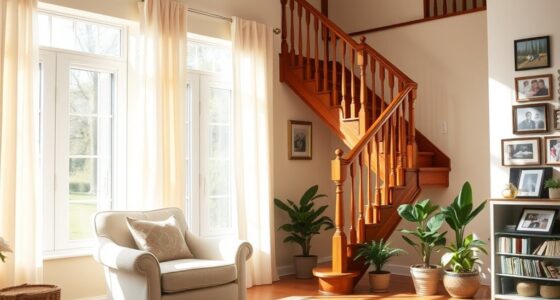To finance home modifications, start by evaluating your personal budget and exploring local, state, or federal grants and subsidies that support accessibility upgrades. Programs from agencies like VA or HUD can offer valuable assistance, while specialized loans are also available. Carefully compare these options to find what fits your needs best. Additionally, hiring experienced contractors ensures safe, compliant adjustments. Keep exploring solutions to discover how you can make your home safer and more accessible with available funding options.
Key Takeaways
- Assess personal finances and explore available grants or subsidies from federal, state, or local programs for funding home modifications.
- Research specialized home improvement loan options or lines of credit tailored for accessibility upgrades.
- Apply early for grants, providing detailed needs assessments and documentation to maximize financial support.
- Choose experienced contractors familiar with adaptive equipment and safety standards to ensure effective and compliant modifications.
- Utilize online resources to identify vetted products and funding opportunities, streamlining the planning and budgeting process.

If you’re contemplating home modifications to improve safety, comfort, or accessibility, figuring out how to finance these upgrades can feel overwhelming. One of the first steps is understanding your options for funding, whether through budget planning, grants, or loans. When it comes to making modifications, consider the role of adaptive equipment—these devices, like grab bars, ramps, or stairlifts, can substantially improve your quality of life. However, installing adaptive equipment often requires professional help, so contractor selection becomes a critical part of the process. Choosing the right contractor ensures that your modifications are safe, effective, and compliant with all relevant standards.
Start by evaluating your personal finances to determine how much you can allocate toward home modifications. If your budget is limited, explore grant options designed for accessibility improvements or disability modifications. Many local, state, or federal programs offer grants or subsidies to help cover the costs of adaptive equipment and structural changes. For example, agencies like the Department of Veterans Affairs or the Department of Housing and Urban Development often provide financial assistance for eligible individuals. Applying for these grants requires careful documentation and sometimes a needs assessment, so be prepared to provide detailed information about your circumstances and what modifications are necessary.
Explore grants and subsidies to fund home modifications for accessibility and safety.
Loan programs are another avenue to contemplate. Some financial institutions offer specialized home improvement loans or lines of credit with favorable terms for accessibility upgrades. These loans can help bridge the gap if your savings and grants aren’t enough to cover all expenses. When planning your project, it’s crucial to research and compare different funding sources to find the best fit for your situation.
Once you’ve identified your financing options, focus on contractor selection. Not all contractors are experienced with adaptive equipment or familiar with accessibility standards, so choose someone who specializes in home modifications for mobility or health-related needs. Check references, review portfolios of previous work, and verify licensing and insurance. An experienced contractor can help you navigate the technical aspects of installing adaptive equipment, ensure compliance with safety standards, and advise on cost-effective solutions. Their expertise is essential to ensure that your upgrades are durable, safe, and tailored to your specific needs. Additionally, understanding Glycolic Acid and its benefits for skin can be helpful if your modifications include skin therapies or treatments.
Being aware of available financing options can significantly ease your planning process and reduce financial stress during your home modification project. Exploring the role of professional contractors with experience in adaptive equipment can ensure your project meets all safety and quality standards. Furthermore, incorporating knowledge about vetted products can help you select safe and reliable equipment for your modifications. Consider researching funding sources early in your planning to maximize your financial options and streamline the process.
Frequently Asked Questions
Are There Tax Deductions Available for Home Modifications?
You might be able to claim a tax deduction for certain home modifications if they qualify as medical expenses. These are considered home improvements for medical purposes, such as installing ramps or grab bars. Keep in mind, you can only deduct expenses that exceed 7.5% of your adjusted gross income. Be sure to maintain receipts and consult a tax professional to verify your home improvements qualify as deductible medical expenses.
How Do I Qualify for Government Grant Programs?
To qualify for government grant programs, you need to verify the eligibility criteria carefully, which often include age, income level, or specific needs. Start by researching the programs available in your area, then follow the application process step-by-step, gathering required documents and filling out forms accurately. Keep track of deadlines and stay in touch with program officials to ensure your application is complete and increases your chances of approval.
Can I Combine Multiple Financing Options for My Project?
You can often combine multiple financing strategies for your project, but it depends on the specific funding sources and their rules. Check with each program or lender to guarantee they allow stacking or combining funds. By exploring different funding sources, you can maximize your budget and access more resources. Just make sure to understand any restrictions or requirements so your financing plan stays smooth and aligned with your project goals.
What Is the Average Timeline for Approval and Funding?
You might wonder about the approval process and funding timeline for home modifications. Typically, the approval process can take anywhere from a few weeks to a couple of months, depending on the program and completeness of your application. Once approved, the funding timeline varies, but you could expect disbursement within a few weeks. Staying organized and promptly providing required documents helps speed up both approval and funding, so plan accordingly.
Are There Special Considerations for Elderly or Disabled Homeowners?
Think of your home as a fortress where senior safety and disability accessibility are top priorities. For elderly or disabled homeowners, there are often special considerations like priority funding, reduced paperwork, and tailored grants to guarantee essential modifications are made smoothly. You might also find programs designed specifically for disability accessibility, helping you create a safer, more comfortable environment that meets your unique needs. Don’t hesitate to explore these tailored options to protect your independence.
Conclusion
When it comes to financing your home modifications, remember there’s a toolbox of options waiting for you—grants, loans, or budget plans. Think of it as planting seeds now so your future stays accessible and comfortable. With a little research and planning, you can turn your home into a welcoming haven that grows with your needs. Don’t let finances hold you back; instead, embrace the opportunities ahead and watch your efforts blossom into lasting comfort.









